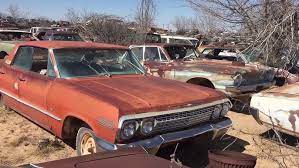Auto salvage yards are havens where worn and weary vehicles find new purpose through disassembly and Recycling. These locales, also dubbed auto recyclers, junkyards, or scrap yards, serve as linchpins in the tapestry of the auto recycling industry—a domain dedicated to the careful disposal and reinvigoration of end-of-life automobiles.

Energy and jobs were saved, and local economies were boosted. Car owners discover the green road. Unveil auto recycling's secrets—rebirth for your vehicle.
Auto recycling emerges as an ecological tapestry woven with myriad benefits. Its threads weave through waste reduction, pollution abatement, and energy conservation while nurturing job landscapes and bolstering local economies. A symphony of advantages resonates with vehicle owners and seekers alike. A serenade to monetary gains or tax deductions for unwanted cars, a symposium on quality used components or budget-friendly vehicles. Embark on a journey through the inner workings of auto salvage yards, explore the bounty of auto recycling, and discover the art of responsibility.
How do auto salvage yards reduce waste?
These havens possess the power to rescue and repurpose components from aged vehicles, thwarting the march to landfills – a realm where hazardous elements could taint soil and water. The U.S. Environmental Protection Agency (EPA) discloses that recycling a single ton of steel shields 2,500 pounds of iron ore, 1,400 pounds of coal, and 120 pounds of limestone. This recycling ballet extends its influence to manufacturing, rendering the birth of new parts less urgent – a stance that throttles energy consumption and quells the emission of greenhouse gases. Thus, auto salvage yards emerge as guardians of environmental balance, weaving a tapestry of sustainability by quelling the tide of waste.
How do auto salvage yards reduce pollution?
Waste Abatement: Within their grasp lies the power to rejuvenate aged vehicles, safeguarding them from a landfill-bound destiny, where they could bestow toxic taints upon the soil and waters. As per the U.S. Environmental Protection Agency (EPA), they recycle a ton of steel shields, 2,500 pounds of iron ore, 1,400 pounds of coal, and 120 pounds of limestone.
Energy Redemption: Through furnishing an alternative reservoir of components for vehicular repairs and maintenance, these yards deflect the need to birth fresh parts through resource-intensive manufacturing. This process exhales energy and generates greenhouse gasses. The EPA asserts that recycling steel salvages a staggering 74% of the energy that virgin steel production would devour.

Resource Resurrection: Emanating from their core is the extension of life cycles for parts born of yesteryears’ vehicles. They quiet the clamor for new raw materials – metals, plastics, rubber, glass – sparing nature’s bounty. This intricate dance preserves biodiversity, halts the tide of water and air pollution birthed by extraction and processing activities, and reverberates with a resonance of environmental harmony.
Hence, auto salvage yards unveil their noble role in steering the ship of environmental sustainability, a role embraced through waste reduction, energy conservation, and the stewardship of precious natural resources.
How do auto salvage yards reduce greenhouse gas emissions?
A New Wellspring: Within their realm, a treasure trove of vehicle repair and upkeep components emerges, diminishing the demand for the birth of novel parts. This act shuns energy-intensive manufacturing, which exhales greenhouse gasses. The U.S. Environmental Protection Agency (EPA) unveils that recycling steel redeems 74% of the energy destined for creating virgin steel from base materials. Moreover, this ballet curtails greenhouse gas emissions by 86%.
Nature’s Guardian: The dance goes beyond steel, embracing metals, plastics, rubber, and glass – cherished elements of the automotive symphony. By revitalizing these, auto salvage yards mitigate the environmental toll of mining and processing activities. A realm of nature’s preservation unfolds.
Ergo, the role of auto salvage yards as environmental sentinels are illuminated – a role that befits the reduction of greenhouse gas emissions, a vital stride in the waltz of environmental harmony
How do auto salvage yards conserve natural resources?

Extending Legacies: They breathe new life into old vehicle parts, unraveling a narrative of prolonged existence. This act dampens the clamor for fresh raw materials – metals, plastics, rubber, glass – sparing Mother Earth the burden of extraction and processing. A ballet that echoes in biodiversity preservation and pollution reduction chambers as mining and processing bow in defeat.
A Symphony of Savings: Envision the cascade of impact when steel is recycled – 1.5 tons of iron ore and 0.5 tons of coal redeemed, along with a 40% reduction in water thirst. The U.S. Environmental Protection Agency (EPA) paints this symphony while also whispering of dwindled energy consumption and quelled greenhouse gas emissions ushered in by the reduction in new part manufacturing.
How do auto salvage yards support various industries and sectors?
Steel’s Muse: They bestow over 14 million tons annually to the steel industry – steel born from recycled vehicles’ souls. A cycle that kindles energy preserves nature’s wealth and thwarts the exhalation of greenhouse gases—a beacon of sustainability against virgin steel’s tale.
Reviving Auto Parts: The auto parts realm finds solace in their embrace. An oasis of spare parts sprouts, beckoning vehicle revival. An ode to affordability and accessibility, a canvas painted with alternative avenues to newness.
Nature’s Guardians: In environmental guardianship, they emerge as sentinels. The bounty of pollutants poised to infiltrate soil and water is thwarted. Hazardous fluids, banished with care – engine coolant, oil, transmission fluid, air conditioning refrigerant, gasoline, batteries, and catalytic converters.

Charitable Threads: Charitable circles find an ally, as vehicle donations find haven. Tax deductions dance into donors’ lives, while charities harness the tide of funds from vehicle sales to fuel their noble causes.
Thus, auto salvage yards partake in a tapestry of support, sculpting a destiny woven with economic, environmental, and social threads.
How do auto salvage yards benefit social causes and enterprises?
Economic Enclaves: A symphony of income and employment unfurls within their embrace. A stage is shared by the salvage industry’s workforce and the artisans who breathe life into rescued vehicles – be it for personal needs or commercial ventures.
Eco-Guardians: The environmental tale they scribe involves Recycling, breathing life into reusable materials and parts, and ensuring the safe demise of hazardous elements that imperil nature and human well-being.
Charitable Threads: Charitable circles bask in their benevolence. Organizations like Habitat for Humanity find companionship as vehicle donations pave the way to building affordable homes for needy families.
Hence, auto salvage yards emerge as societal keystones, enriching economic and generous realms with their transformative essence.
FAQs
Recycling waste is a resource-saving marvel. It curtails the necessity for fresh raw materials like trees, metals, water, and minerals. Doing so shields precious resources from over-extraction, preserving our planet’s natural wealth.
Behold the power of Recycling in curbing emissions. It slashes greenhouse gases and air pollution by saving energy and circumventing the burning of fossil fuels. For example, Recycling just one ton of aluminium cans rescues 14,000 kWh of electricity, matching a year’s usage for 12 households.
Recycling acts as a sentinel against environmental hazards. It curbs the flow of waste into landfills and incinerators, thwarting the release of harmful chemicals into the air and soil. This proactive stance mitigates health risks while creating economic prospects for recycling industries.
Recycling matters profoundly, crafting a harmonious world. It guards our environment, nurtures resources, and champions energy efficiency. Moreover, it sparks social growth, raising awareness, fostering engagement, and nurturing well-being. In a world of complexities, Recycling is a simple yet impactful tool for a brighter future.
- Reduces waste generation, sparing soil, water, and air from pollution.
- Battles energy waste and emissions, curbing greenhouse gases.
- Safeguards natural balance by protecting resources and ecosystems.
- Elevates life quality through green jobs and thriving communi
Recycling emerges as a sentinel in the face of environmental adversities. It wields the power to combat climate change’s grip, mend resource scars, cleanse pollution’s stain, and revolutionize waste’s destiny. The Symphony of Recycling conducts harmony – from curbing greenhouse gases to safeguarding our finite natural treasures. The air, land, and water rejoice in this stewardship, and as we embrace Recycling, we set the stage for a sustainable legacy where materials reawaken and inspire a mindful coexistence.
- Cut waste, dodge landfills.
- Transform waste into treasures.
- Save energy, resources, and emissions.
- Mitigate pollution’s grip.
- Foster circular economy, fuel social growth.
- Manage waste efficiently.
- Collect, sort, transform.
- Governments, companies, and nonprofits drive it.
- A versatile tool with diverse goals.
- Mechanical: Shape change, purity retained.
- Chemical: Molecular rebirth, new substances born.
- Biological: Organic renewal through natural processes.
Final Analysis
This article has unveiled the environmental significance of auto salvage yards. Acting as sanctuaries for worn vehicles, they orchestrate the ballet of waste reduction, energy savings, and economic fortitude. In this tapestry of sustainability, car owners find solace – by trading unwanted vehicles for cash or deductions or embracing quality used parts and affordable rides. Auto recycling emerges not only as a responsible path for old cars but also as a rewarding voyage towards a greener tomorrow, enriching lives and landscapes alike.
